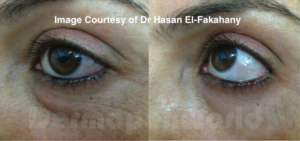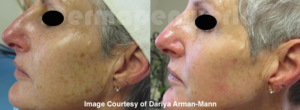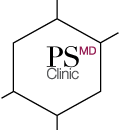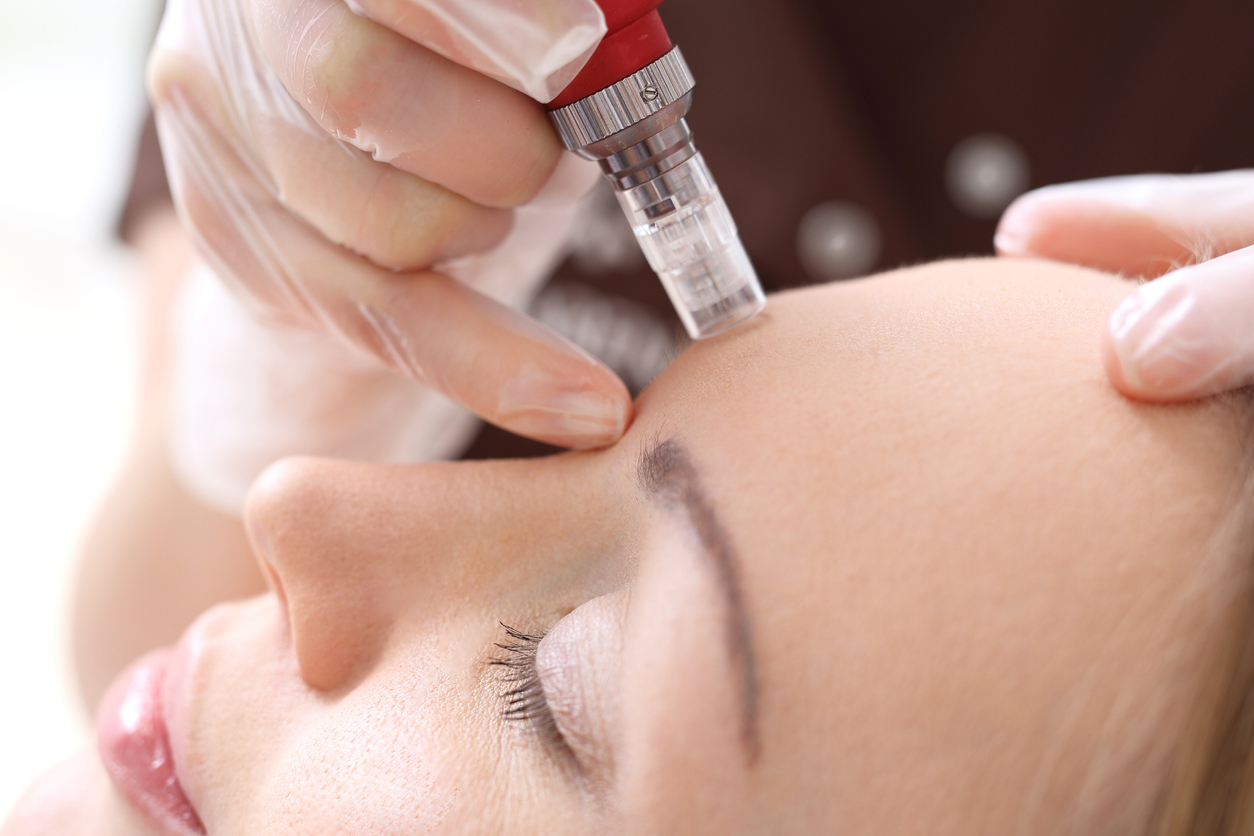Dr Kim explains why microneedling remains a firm favourite treatment with her patients.
As many of my patients already know, I am a huge fan of medical microneedling for skin rejuvenation. Used in a responsible way, with extensive training and impeccable technique, microneedling can lead to fairly dramatic results in even the most problematic of skins. In most cases, medical microneedling involves use of an electronic device with a disposable cartridge to open tiny channels in the skin to stimulate collagen and elastin production and enhance delivery of targeted skin products to the deeper layers of the skin. Titanium micro-pins are used at personalised depths in different areas on the face, and this will differ for each patient. A good understanding of dermatology, and the anatomy of the skin, as well as the action of ingredients that will work best for different skin concerns in conjunction with the microneedling treatment, is very important in order to avoid activating an adverse inflammatory response which could lead to complications or poor results.
What does microneedling actually do?
At The PSMD Clinic we use the Dermapen devices. This is the original electronic device and the techniques and products are highly researched and established over many years. The micro-pins penetrate the skin to the exact layer you are targeting for the specific skin concerns. This triggers a healing cascade in the skin including release of growth factors that will address specific needs within the skin. Targeting a specific depth in the skin is really important. For example, for pigmentation, you are targeting the outer layer of the skin, the epidermis, where the melanocytes are concentrated. For skin rejuvenation, you are targeting the deeper dermis, so that the products and microneedling can stimulate the fibroblasts. This leads them to produce collagen and elastin, the scaffold that provides the structure to the skin, and hyaluronic acid, the jelly that provides the plumpness and hydration in the skin.
Over a course of treatments, your doctor is likely to customise each individual treatment so that you can address multiple skin concerns over a period of time, as well as adjusting for downtime according to your social calendar.
What ares can microneedling treat?
Microneedling is widely used on the face, neck and décolleté, but it can be used anywhere on the body. I use microneedling alongside many of the more advanced radiofrequency treatments as it is safe and effective to use in delicate skin around the eyes. It is a particularly useful treatment for stretchmarks and scarring on the body in areas where use of an energy-based platform is mostly avoided eg over the thyroid or breasts. I commonly use microneedling to treat surgical scarring or stretchmarks on breasts and stomachs, and I’ve recently started treating my own forearms as years of sun exposure on my hands and forearms has resulted in noticeable photodamage – the right arm worse than my left from driving. If you have any areas on your body that bother you, please mention that during your skin assessment consultation.
Is microneedling painful?
It took me a while to start doing microneedling in my own practice as I took part in a dermal roller clinical trial early in my aesthetic career and found it incredibly uncomfortable. I was thrilled with the results, but couldn’t see how my patients would agree to come back for a full course of treatments (very important to achieve optimal results with microneedling) as I found it so painful. This changed when I discovered the electronic devices which use vibration to deliver the micro-channels. Vibration blocks the pain receptors in the skin which makes the treatment far more comfortable. Even so, at The PSMD Clinic, we are inclined to use a good topical numbing cream to ensure that the treatment is comfortable and that you will be sure to come back to complete your course!
Is there any downtime with microneedling?
It does depend a little on the depth of the treatment, and the products used alongside the treatment, but most people will experience some redness for anywhere between 2 and 48 hours after a treatment. This looks a little bit like you’ve sustained a sunburn, or had a hard work-out in the gym. The redness can be reduced by use of a good post-procedure product and vitamin C and E serum, but can be unpredictable, so it’s best not to arrange a social event the same day as a treatment, just in case. My favourites post-procedure products are from our own skin range, PSMD Skin Science, or SkinCeuticals Phytocorrective and CE Ferrulic serums. For patients who are particularly prone to redness, I recommend trying the Dermalux LED light therapy straight after microneedling.
When can I expect to see results?
Some people will see results within 2 weeks after their first treatment, but in most cases, collagen production is more noticeable after about 6 weeks. In some cases, results will be better after a course of 3 to 6 treatments.
Can I have microneedling if I am pregnant or breastfeeding?
Yes, this is one of the few more advanced skin rejuvenation and brightening treatments that can be safely done if you are pregnant or breastfeeding. It is important that you discuss this with your doctor as they will ensure that they use products that are safe for use in conjunction with the treatment.
Benefits of microneedling:
- Skin tightening
- Natural collagen induction
- Lifting and rejuvenating
- Reduces wrinkles and fine lines
- Minimises pore size
- Management of hyper- and hypo-pigmentation
- Improves stretchmarks
- Used in hair regeneration and hair thinning
- Improvement of acne scarring and surgical scars

Figure 1. Improvements in skin quality around the eyes after a course of microneedling
(images courtesy of Dermapen)

Figure 2. Improvements in overall skin texture and tone after a course of microneedling
(images courtesy of Dermapen)

Figure 3. Improvements in acne scarring after a course of microneedling
(images courtesy of Dermapen)


